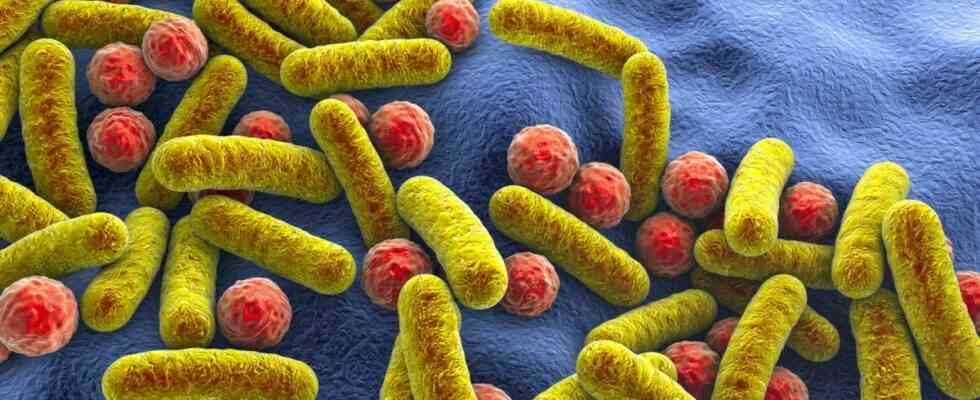In an apartment in the east of Munich, a sparkling water bottle has been standing next to the sink for some time. Just turning on the tap and brushing your teeth with tap water isn’t a particularly good idea right now. The pipes throughout the house are infested with legionella. The bacterial infestation is the result of a savings measure, because due to rising energy prices, a property manager had reduced the flow temperature of the hot water system in the building to less than 50 degrees. Experts warn against trying to reduce additional costs with such interventions.
In larger residential complexes, it often happens that the limit values for legionella are exceeded. “In the months of August and September 2022, it was necessary in a total of 32 cases in the Munich city area to restrict use in the sense of a shower ban,” says a spokesman for the health department. Excessive legionella levels in drinking water must be reported, and laboratories are obliged to contact the health authorities if they detect elevated levels. Then the authorities tell the property management what they have to do to eliminate the burden.
At the present time, it is not apparent that there is an accumulation of cases in Munich that are associated with a drop in water temperatures, says the spokesman for the department. In addition, there are always fluctuations over the year. For example, from the beginning of August to the end of September last year, the health department registered 26 cases in which the legionella concentration was so high that a restriction on use had to be imposed. In June and July this year there were 45 cases.
Bacteria that like to live in water pipes
Legionella are bacteria that occur worldwide in surface waters or groundwater – but also in other moist places. Water temperatures between 25 and 50 degrees offer ideal conditions for the microorganisms. At these temperatures, they spread by leaps and bounds. Above 60 degrees they are killed, below 20 degrees they hardly multiply. The germs find good conditions in many water pipes in buildings, in deposits and deposits in the pipe system. But swimming pools, whirlpools or air conditioning systems are also regularly infested.
In polluted systems, people can become infected, for example when taking a shower or cleaning the sink, by inhaling the finest water droplets. When drinking, infection cannot be ruled out, but only rarely occurs, according to the Federal Center for Health Education. If the pathogens get into the lungs, they can trigger a flu-like illness known as “Pontiac fever” or severe pneumonia, also known as legionellosis or Legionnaires’ disease. Immunocompromised and older people are particularly at risk, as are smokers. Men get sick more often than women.
Despite the energy crisis, experts advise setting hot water to at least 55 degrees or 60 degrees.
(Photo: Florian Peljak)
The Robert Koch Institute (RKI) estimates that there are between 18 and 36 infections per 100,000 inhabitants per year in Germany. The number of cases increases especially in the autumn and summer months. If left untreated, Legionnaires’ disease can be fatal. According to the RKI, this is the case for five to ten percent of those who are ill. In any case, the Munich clinics – which maintain specialist departments for legionella in the houses in Bogenhausen, Schwabing and Harlaching – do not find more sick people at this time. “Currently or in the past few weeks, no accumulation of any kind could be observed,” says a spokesman.
Owners are obliged that drinking water does not endanger health
“On average, around twelve percent of the total energy consumption of private households in Germany is required to provide hot water,” according to the Federal Environment Agency. So it is not an insignificant item in the household book that could supposedly save. Since saving energy and hygiene cannot always be reconciled, there are legal requirements. This is the only reason why the legionella contamination in the apartment building in the east of Munich was noticed at all. Since the Drinking Water Ordinance was changed in 2012, large systems for heating drinking water have had to be checked regularly for legionella. The regulation affects apartment buildings in which there are more than two residential units. In the past ten years, according to the health department, about 10,000 buildings in the city area have been reported as having or still having legionella problems.
In the apartment building must according to a message from the Federal Environment Agency “at the outlet of the drinking water heater” a temperature of 60 degrees must be maintained permanently, in the entire water cycle temperatures of 55 degrees must not be fallen below. “The protection of human health is clearly above the intention to save energy,” writes the Federal Office. Turning down the water temperature in an apartment building is actually not allowed. The situation is different in detached and semi-detached houses. There are no statutory test intervals or specifications for the minimum temperature. Both the Federal Environment Agency, the German Gas and Water Association and the State Office for Health and Food Safety recommend that the water not leave the boiler at less than 55 degrees, even with shorter pipe runs.
In the apartment in the east of Munich, the soda bottle will be left for a while next to the sink. While Legionella establish themselves relatively quickly, getting rid of them takes time – usually several months.

